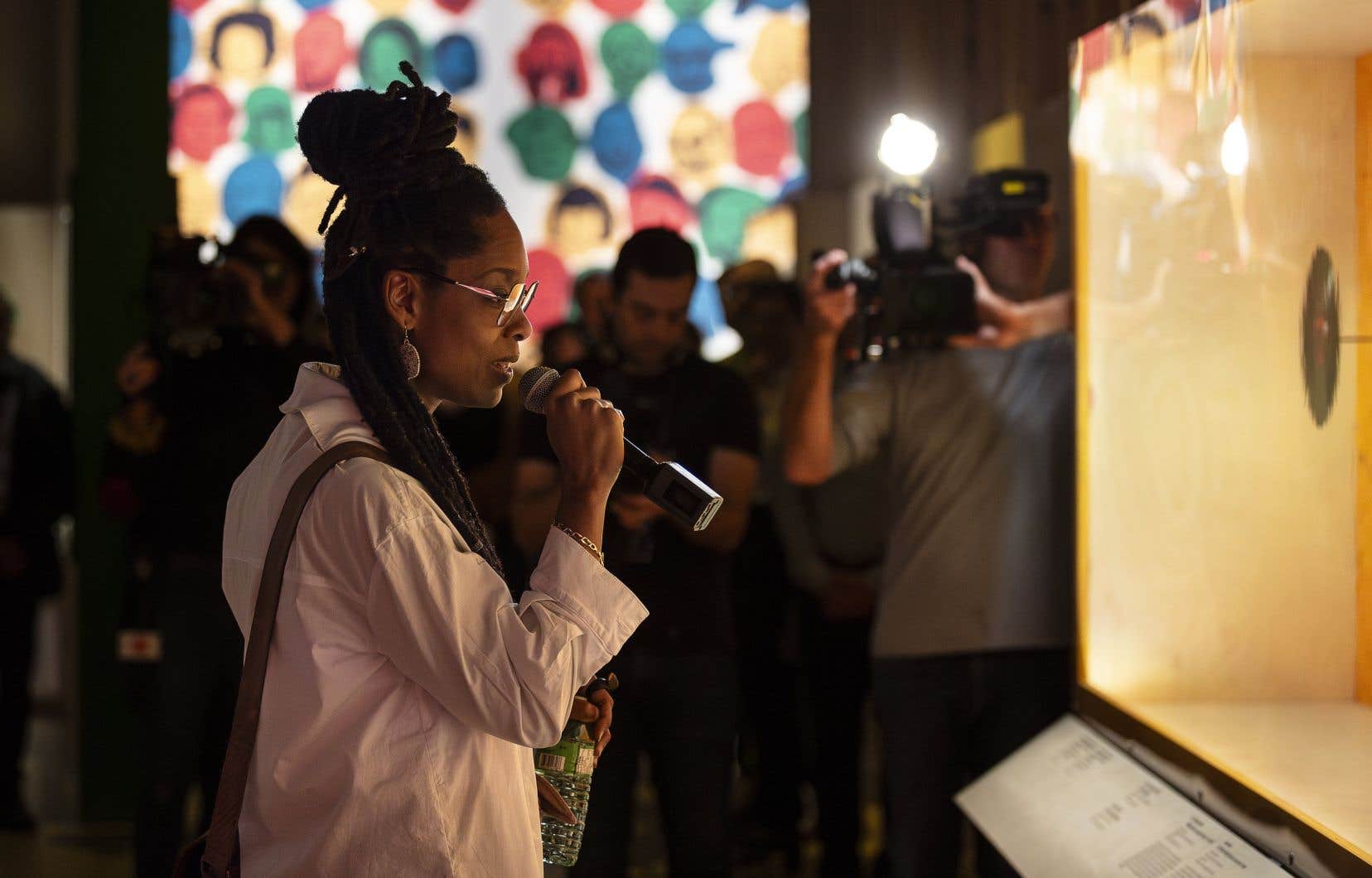Initially emerging from the margins, Quebec rap has made its way over the past 40 years and has carved out a special place for itself in the hearts of the general public. The exhibition On words. The sound of queb rappresented at the Musée de la civilization de Québec until September 2, 2024, pays homage to local hip-hop culture in all its forms.
From the entrance, an enormous cardboard pendant — similar to the gold ones found on rappers’ necks — sets the tone of the exhibition. Before starting their journey, visitors are given headphones and a device that captures different sound clips that change depending on where you are.
While the snowflakes cover the capital outside, the rap rhythms warm the ears of those who wander from one room to another of the museum. One of the first stops is in a dark room where colorful, dancing silhouettes are projected on the screen, while DJ Nerve on the decks blares through headphones. The animators of this block party [fête de quartier] then encourage the public to go listen to a “cypher”, a gathering of hip-hop artists in a circle, during which we notably hear the rappers Naya Ali and Calamine.
One of the pioneers of rap in Quebec and member of the Muzion trio, Jenny Salgado, was present at the passing of the Duty on scene Thursday. Hip-hop, which is often portrayed as coming from suffering and misery, is much more than that, she emphasizes. “It is above all a culture of resourcefulness, of good manners, of “by any means necessary, we will get there”. It’s the right to dream. »
It is above all a culture of resourcefulness, of good manners
Hip-hop artist Aly Ndiaye, alias Webster, and Webster speaker, drew his courage from this culture in order to approach the Musée de la civilization to create this exhibition. Although the idea was immediately well received by the institution, the people who worked there initially wondered how to make this subject “museological”. “I replied: ‘If you are capable of doing an exhibition on poop, I have confidence in you,’” he relates, referring to the past exhibition Oh shit!before bursting out laughing.
Back to the roots
Webster says he cried while wandering through the different rooms of On words. The sound of queb rap. “It was very emotional for me to see my life on the walls of a museum of pan-Canadian significance and illustrated with respect. That is to say, the institution let us in and tell our story. »
The exhibition demonstrates, among other things, the progress made by local hip-hop by presenting some 200 objects, including awards, archives, as well as numerous cassettes and CDs. Before beginning their journey between these, visitors first land in an area which reminds us that it was mainly members of the Afro-descendant community in Quebec who allowed hip-hop to make its way here. In the 1980s and 1990s, they brought cassettes back from New York, where this culture was born in the 1970s.
The beginnings of this culture in Quebec are therefore not attributable to Pope of rap by Daniel Lavoie or at Rap-a-Billy by Lucien Francoeur, insists Webster. “They’re not people from the hip-hop community. »
Rather, this culture was made by those who lived on the margins and were not represented in the media and cultural spheres of society. “In Quebec, we did not see our realities. As an Afro-Quebecer, as a racialized person, as a person from forgotten neighborhoods, we didn’t see ourselves. So, that’s how hip-hop spoke to us. And that’s how we made hip-hop a Quebec culture,” says the speaker.
Rap is also a voice for other communities, such as Indigenous people, notes Webster.
Part of the exhibition is also devoted to racial profiling and incarceration. “On the margins, well there are also people who have been incarcerated. These are notably the symptoms of systemic racism,” he laments, looking at the letters on the wall intended for a rapper who had been imprisoned.
Women of hip-hop “everywhere”
Throughout the exhibition, the female rappers mingle with their colleagues. “That was an important point for us,” says Webster. That is to say, not to do just [une section] for women in rap and after that we continue and then it’s a men’s business. The question is not there. Women must be found everywhere. They’re female rappers, period. »
Women must be found everywhere. They’re female rappers, period.
They also have their place in the immense blue, green, yellow and red mural by Vincent Tourigny which illustrates the artisans of Quebec hip-hop like Sarahmée, Marie-Gold, FouKi, Zach Zoya and Biz. On the other side of this work, visitors can witness a battle of beatbox broadcast on a screen during which artists Spectrax and Andre Gibson compete to measure their vocal skills.
The goal of the exhibit was to reveal the many facets of hip-hop, Webster says. “It’s about finding that balance so that the general public is interested, but so are people from that culture. »
